I’m thrilled to share my experience with the Pottery Barn Cameron Sleeper Sofa—it’s a game-changer for anyone needing style, comfort, and functionality in one package.
Whether you’re furnishing a cozy apartment or a spacious living room, this sleeper sofa blends classic design with practical versatility. Its plush cushions, sturdy frame, and easy-to-use pull-out bed make it a must-have for hosting guests or maximizing small spaces.
Trust me, if you’re looking for a sofa that works as hard as it looks good, the Cameron is calling your name. Let’s explore why it’s worth every penny.
My Experience With The Pottery Barn Cameron Sleeper Sofa
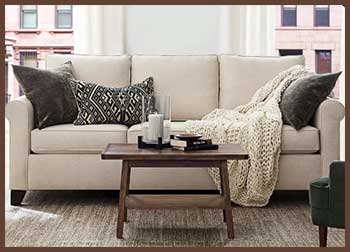
When I first laid eyes on the Pottery Barn Cameron Sleeper Sofa, I was smitten.
Its rolled arms and clean lines screamed timeless elegance, but I wasn’t just after looks—I needed a sofa that could handle my lifestyle.
Living in a two-bedroom condo, I often host friends and family, and my spare room doubles as an office.
A sleeper sofa was the perfect solution, but I was skeptical about finding one that didn’t scream “futon” or sacrifice comfort for function.
Enter the Cameron, which I ordered in a soft oatmeal basketweave fabric after agonizing over the 100+ fabric options.
Delivery was a breeze with Pottery Barn’s white-glove service. Two guys showed up, set it up in my living room, and hauled away the packaging—no assembly required, which was a relief. The first thing I noticed was the weight of the sofa.
At 115 pounds for the 88-inch model, it felt substantial, like it wasn’t going anywhere. I plopped down, and the cushions were a dream—firm enough to support my back but soft enough to sink into during a Netflix binge. The memory foam mattress was a pleasant surprise, too.
My brother crashed on it for a weekend and raved about how it didn’t leave him with a sore back, unlike my old guest mattress.
Over the past year, the Cameron has been a workhorse. It’s survived movie nights, wine spills (thank you, performance fabric), and my cat’s occasional clawing attempts. The pull-out mechanism is smooth, taking about three minutes to convert into a bed.
I’ve even used it as my primary couch for daily lounging, and it’s held up beautifully. The only hiccup? I wish I’d known how much I’d obsess over keeping the slipcover wrinkle-free. But honestly, that’s a small price to pay for a sofa that’s become the heart of my home.
Pros of The Pottery Barn Cameron Sleeper Sofa
- Timeless Design That Fits Any Space
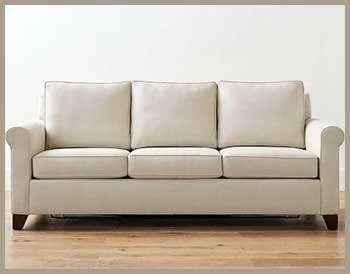
The Cameron’s classic English roll-arm style is a showstopper.
Whether your vibe is modern farmhouse or urban chic, this sofa fits right in.
The curved arms and tapered hardwood legs give it a refined look without feeling stuffy.
I’ve gotten compliments from everyone—my minimalist sister to my traditionalist mom.
Plus, with three sizes (63-inch loveseat, 88-inch sofa, and 98-inch grand sofa), you can pick one that suits your room. I went with the 88-inch, and it’s perfect for my medium-sized living room without overwhelming the space.
- Unmatched Customization Options
You’ve got choices galore with the Cameron. Pottery Barn offers over 100 fabric options, from linen blends to performance velvets, so you can tailor it to your taste. I chose the basketweave slub in oatmeal for its subtle texture and stain resistance, but you can go bold with a chambray or classic with leather.
You can even mix and match cushion fills—memory foam for firmness or down blend for a softer feel. This level of customization means you’re not just buying a sofa; you’re creating one that’s uniquely yours.
- Comfort That Delivers Day and Night
Let’s talk comfort. The Cameron’s seat cushions are medium-firm, striking a balance that supports you during long sits but feels cozy for naps. The back cushions, filled with fluffy poly-fill, are like hugging a cloud. As a sleeper, it’s a standout.
The 5-inch memory foam mattress is supportive enough for guests to sleep soundly, and I’ve even caught myself dozing off on it during late-night movie marathons. My friends have called it “hotel bed comfortable,” which is high praise for a pull-out.
- Durable Construction for the Long Haul
This sofa is built like a tank. The frame, made of kiln-dried plywood and steel springs, feels rock-solid. I’ve had no creaks or wobbles, even after a year of heavy use. The soy-based foam cushions are eco-friendly and hold their shape better than the cheap poly-filled sofas I’ve owned before.
Pottery Barn’s focus on sustainability also means no flame retardants, which gives me peace of mind. If you’re investing in furniture, you want it to last, and the Cameron’s sturdy bones make it a contender for decades of use.
- Easy-to-Clean Performance Fabrics
Spills happen, especially when you’re clumsy like me. The Cameron’s performance fabrics, like Sunbrella or Crypton, are a lifesaver. I’ve tackled coffee splashes and a rogue ketchup stain with just water and a cloth, and the fabric still looks pristine.
The slipcover is removable and washable, which is a godsend for pet owners or parents. Even after multiple washes, my oatmeal slipcover hasn’t faded or shrunk, though I always air-dry it to be safe. This sofa makes it easy to keep your space looking fresh.
Not-So-Good Parts of The Pottery Barn Cameron Sleeper Sofa
- Premium Price Tag
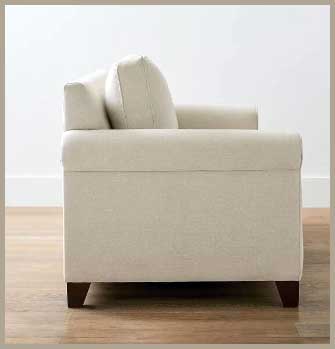
Let’s be real: the Cameron isn’t cheap.
Prices range from $899 to $2,329 depending on size and fabric, and that’s before taxes and delivery fees.
My 88-inch model set me back about $1,200 on sale, which stung a bit. Compared to budget brands like IKEA, it’s a significant investment.
That said, I’ve learned the hard way that cheaper sofas sag and break down faster, so the Cameron’s quality justifies the cost for me.
If you’re on a tight budget, you might need to save up or wait for a sale.
- Firm Armrests Lack Cushioning
The rolled arms look gorgeous, but they’re not the comfiest for lounging. They’re firm with minimal padding, so leaning on them for long periods isn’t ideal. I’ve caught myself propping pillows against them when I’m sprawled out watching TV.
If you’re someone who loves resting your head on the armrest, this might bug you. It’s a minor gripe, but I wish Pottery Barn had added a bit more cushioning to make the arms as cozy as the seat.
- Weight and Space Considerations
At 115 pounds for the sofa size, the Cameron is heavy. Moving it for cleaning or rearranging is a two-person job, and I’ve strained my back trying to nudge it alone.
The sleeper mechanism adds to the bulk, so make sure you measure your space carefully. It’s also deeper than some sofas at 36 inches, which is great for lounging but might feel bulky in a tiny apartment. If you’re tight on space, the loveseat version might be a better fit.
- Slipcovers Require Regular Maintenance
While the slipcover is a pro for cleaning, it’s also a bit of a hassle. Mine tends to wrinkle after heavy use, and I find myself tucking it in weekly to keep it looking sharp. Washing and air-drying the slipcover takes effort, and if you’re not diligent, it can start to look sloppy.
I’ve also noticed that the fit isn’t always perfect after washing, requiring some finessing to get it back on smoothly. It’s not a dealbreaker, but it’s something to consider if you prefer low-maintenance furniture.
Maintenance Tips For Your Pottery Barn Cameron Sleeper Sofa
- Regular Vacuuming to Prevent Dust Buildup
Dust and pet hair love to cling to fabric, so I vacuum my Cameron weekly using the upholstery attachment. Focus on the crevices where crumbs hide, especially if you snack on the couch like I do.
For the sleeper mattress, I give it a quick vacuum every time I fold it out to keep it fresh for guests. A handheld vacuum works wonders for quick touch-ups, and it only takes five minutes to keep the sofa looking brand-new.
- Spot-Cleaning Spills Immediately
Accidents happen, but performance fabrics make cleanup a breeze. When I spilled wine (oops), I blotted it with a damp cloth and mild soap, and the stain vanished. Always blot, don’t rub, to avoid pushing the spill deeper into the fabric.
For tougher stains, check Pottery Barn’s care instructions for your specific fabric—some can handle a diluted bleach solution. Acting fast is key to preventing stains from setting, so keep a clean cloth handy.
- Washing and Caring for the Slipcovers
The slipcover is machine-washable, but I learned to wash it in cold water on a gentle cycle to avoid shrinkage. Air-drying is a must—toss it in the dryer, and you might end up with a too-tight fit. I wash mine every few months, depending on how much use it gets.
To reattach, start at the corners and work your way around to ensure a snug fit. It’s a bit like wrestling a fitted sheet, but it’s worth it for that crisp look.
- Fluffing and Rotating Cushions
To keep the cushions plump, I fluff them every couple of weeks by giving them a good shake and punch. Rotating the seat cushions monthly helps distribute wear evenly, especially if you have a favorite spot like I do.
For the back cushions, I flip them top to bottom to prevent sagging. This simple habit keeps the Cameron looking as good as the day it arrived and extends the life of the foam.
- Protecting the Frame and Mechanism
The sleeper mechanism is sturdy, but I’m careful not to force it when converting it to a bed. Lubricate the metal parts with a silicone spray every six months to keep it smooth. For the wooden legs, I use a furniture polish to prevent scratches and maintain their shine.
Avoid dragging the sofa across the floor—it’s heavy, and you could damage the legs or frame. A quick check of the screws under the frame every year ensures everything stays tight.
Comparison of Pottery Barn Cameron Sleeper Sofa With Other Brands
I’ve pitted the Pottery Barn Cameron Sleeper Sofa against three competitors—Rowe, Maiden Home, and Home Reserve—to see how it stacks up. Each brand brings something to the table, but let’s break it down to help you decide which one fits your needs.
- Pottery Barn Cameron Vs. Rowe Nantucket Sleeper Sofa
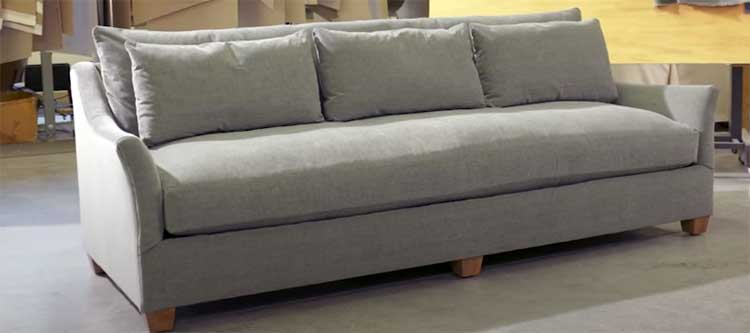
Rowe’s Nantucket Sleeper Sofa is a solid contender with a similar classic vibe, priced between $1,500 and $2,500 depending on fabric. Like the Cameron, it offers customization with over 80 fabric options, but Rowe’s selection leans more toward bold patterns than Pottery Barn’s versatile neutrals.
The Nantucket’s air-coil mattress is comfy for sleeping, but my friend who owns one says it’s thinner than the Cameron’s 5-inch memory foam, so guests might feel the frame after a night or two.
The Nantucket’s frame is also sturdy, but its pull-out mechanism feels less smooth than the Cameron’s, which I can convert in under three minutes. If you want a sofa with a slightly more traditional look and don’t mind a less plush mattress, Rowe’s a great pick, but the Cameron wins for sleep comfort and ease of use.
- Pottery Barn Cameron Vs. Maiden Home The Muir Sleeper Sofa

Maiden Home’s The Muir Sleeper Sofa is a premium option, starting at around $2,000 and going up to $3,500 for leather. Its modern, tufted design is sleeker than the Cameron’s rolled-arm style, making it ideal for minimalist spaces.
Maiden Home focuses on handcrafted quality with a hardwood frame, but its mattress is a standard foam, not memory foam, which I found less supportive when I tested a friend’s Muir. The Muir offers fewer fabric options (about 40), though the quality is top-notch.
Converting the Muir to a bed is smooth, but it’s heavier than the Cameron at 130 pounds, so rearranging is a chore. If you prioritize a chic, artisanal look and don’t need frequent sleeper use, the Muir is tempting, but the Cameron’s customization and mattress comfort give it an edge for versatility.
- Pottery Barn Cameron Vs. Home Reserve Logan Sleeper Sofa
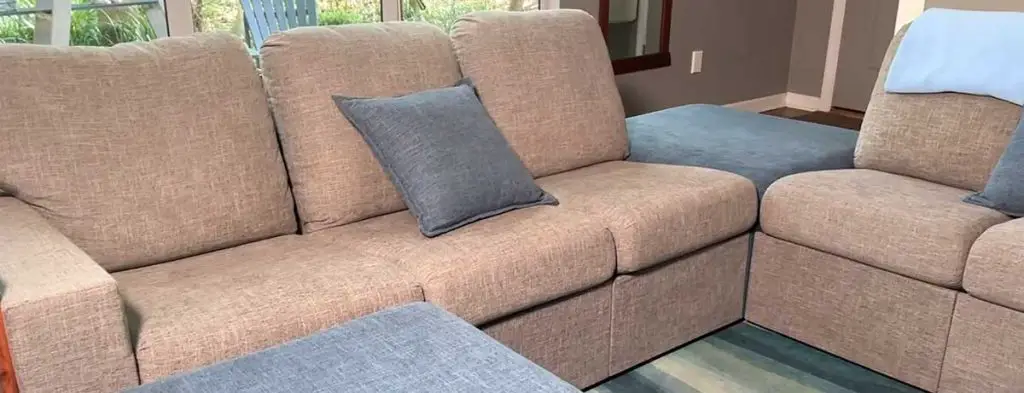
Home Reserve’s Logan Sleeper Sofa is a budget-friendly, modular option starting at $800. What sets it apart is its DIY assembly and customizable sectional pieces, which you can reconfigure as your space changes—perfect for renters like me who move often.
The Logan’s foam mattress is decent but only 4 inches thick, so it’s not as comfy as the Cameron’s memory foam for overnight guests. Fabric choices are limited (around 30), and the quality feels less luxurious than Pottery Barn’s performance fabrics.
My neighbor’s Logan started creaking after a year, while my Cameron’s frame is still silent. If you need flexibility and a lower price, Home Reserve is practical, but the Cameron’s durability and premium feel make it worth the extra cost for long-term use.
The Cameron stands out for its balance of style, comfort, and customization. Rowe’s Nantucket is cozy but lags in mattress quality, Maiden Home’s Muir is stunning but pricier with a less supportive bed, and Home Reserve’s Logan is affordable but lacks the Cameron’s polish.
If you want a sleeper sofa that’s both functional and elegant, the Cameron is your best bet.
Frequently Asked Questions (FAQ)
Yes, the Pottery Barn Cameron Sleeper Sofa is incredibly comfortable for both sitting and sleeping. The seat cushions are medium-firm, offering great support for daily use, while the back cushions are soft and inviting. The 5-inch memory foam mattress is a standout, providing enough support for guests to sleep soundly without the back pain you’d get from thinner pull-out beds. My guests have consistently praised it, and I’ve even napped on it myself without complaint. Compared to other sleeper sofas, it’s a cut above in comfort.
With proper care, the Cameron Sleeper Sofa can last 10-20 years. Its kiln-dried plywood frame and steel springs are built for durability, and the high-quality foam cushions resist sagging better than cheaper alternatives. My sofa still looks and feels great after a year of heavy use, and user reviews suggest Pottery Barn sofas often hold up for a decade or more with regular maintenance. Choosing a performance fabric like Sunbrella or Crypton can extend the lifespan by making cleaning easier and preventing wear.
Pottery Barn sofas, including the Cameron, are made by Williams-Sonoma, Inc., the parent company of Pottery Barn. They’re manufactured in North Carolina using a mix of domestic and imported materials. The Cameron’s frame is crafted from plywood and steel, with cushions made from eco-friendly soy-based foam. Pottery Barn partners with skilled artisans to ensure high-quality construction, which is why the sofa feels so solid. They also prioritize sustainable practices, like avoiding flame retardants, to meet safety and environmental standards.
Conclusion: Why the Cameron Sleeper Sofa Is A Smart Buy?
After a year with the Pottery Barn Cameron Sleeper Sofa, I’m convinced it’s a worthy investment. Its timeless design, plush comfort, and versatile sleeper function make it perfect for any home, whether you’re hosting guests or just lounging.
The durable frame and easy-to-clean fabrics ensure it’ll stay looking sharp for years. If you want a sofa that’s stylish, functional, and built to last, the Cameron delivers. Trust me, you’ll love curling up on this beauty as much as I do. Go for it—you won’t regret it.
